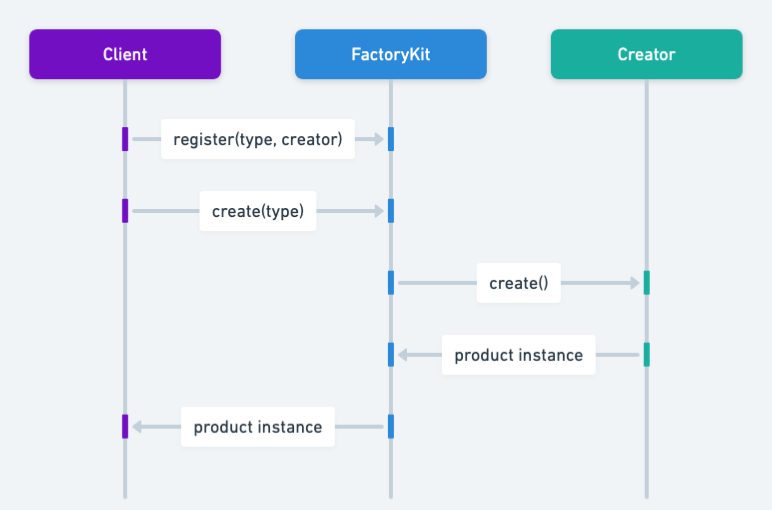Factory Kit Pattern in Java: Crafting Flexible Component Assemblies
Also known as
- Object Kit
- Toolkit
Intent of Factory Kit Design Pattern
The Factory Kit Pattern in Java is a powerful design pattern that helps in creating factories with separated builder and factory interfaces. This pattern is essential for managing complex object creation scenarios.
Detailed Explanation of Factory Kit Pattern with Real-World Examples
Real-world example
An analogous real-world example of the Factory Kit Pattern is a restaurant kitchen where different types of dishes are prepared efficiently. This setup promotes flexibility and consistency, similar to how the Factory Kit Pattern operates in Java. Imagine the kitchen has a central station with various ingredients and recipes registered for different dishes. When an order comes in, the chef consults this central station to gather the necessary ingredients and follow the registered recipe to prepare the dish. This setup allows the kitchen to efficiently manage and switch between different dish preparations without the need for each chef to know the specifics of every recipe, promoting flexibility and consistency in the cooking process.
In plain words
Factory kit is a configurable object builder, a factory to create factories.
Sequence diagram

Programmatic Example of Factory Kit Pattern in Java
Imagine a magical weapon factory in Java capable of creating any desired weapon using the Factory Kit Pattern. This pattern allows for configurable object builders, making it ideal for scenarios where the types of objects are not known upfront.
Upon activation, the master recites the names of the weapon types needed to configure it. Once set up, any of these weapon types can be summoned instantly.
Let's first define the simple Weapon hierarchy.
public interface Weapon {
}
public enum WeaponType {
SWORD,
AXE,
BOW,
SPEAR
}
public class Sword implements Weapon {
@Override
public String toString() {
return "Sword";
}
}
// Axe, Bow, and Spear are defined similarly...Next, we define a functional interface that allows adding a builder with a name to the factory.
public interface Builder {
void add(WeaponType name, Supplier<Weapon> supplier);
}The meat of the example is the WeaponFactory interface that effectively implements the factory kit pattern. The method #factory is used to configure the factory with the classes it needs to be able to construct. The method #create is then used to create object instances.
public interface WeaponFactory {
static WeaponFactory factory(Consumer<Builder> consumer) {
var map = new HashMap<WeaponType, Supplier<Weapon>>();
consumer.accept(map::put);
return name -> map.get(name).get();
}
Weapon create(WeaponType name);
}Now, we can show how WeaponFactory can be used.
public static void main(String[] args) {
var factory = WeaponFactory.factory(builder -> {
builder.add(WeaponType.SWORD, Sword::new);
builder.add(WeaponType.AXE, Axe::new);
builder.add(WeaponType.SPEAR, Spear::new);
builder.add(WeaponType.BOW, Bow::new);
});
var list = new ArrayList<Weapon>();
list.add(factory.create(WeaponType.AXE));
list.add(factory.create(WeaponType.SPEAR));
list.add(factory.create(WeaponType.SWORD));
list.add(factory.create(WeaponType.BOW));
list.forEach(weapon -> LOGGER.info("{}", weapon.toString()));
}Here is the console output when the example is run.
06:32:23.026 [main] INFO com.iluwatar.factorykit.App -- Axe
06:32:23.029 [main] INFO com.iluwatar.factorykit.App -- Spear
06:32:23.029 [main] INFO com.iluwatar.factorykit.App -- Sword
06:32:23.029 [main] INFO com.iluwatar.factorykit.App -- BowWhen to Use the Factory Kit Pattern in Java
Use the Factory Kit Pattern when
- The factory class cannot anticipate the types of objects it must create, and a new instance of a custom builder is needed.
- A new instance of a custom builder is needed instead of a global one.
- The types of objects that the factory can build need to be defined outside the class.
- The builder and creator interfaces need to be separated.
- Game developments and other applications that have user customization.
Factory Kit Pattern Java Tutorials
Real-World Applications of Factory Kit Pattern in Java
- In Java libraries such as the Java Development Kit (JDK) where different rendering engines might be instantiated based on the runtime environment.
- Frameworks like Spring or applications where dependency injection is heavily used, often implement this pattern to manage object creation more flexibly.
Benefits and Trade-offs of Factory Kit Pattern
Benefits:
- The Factory Kit Pattern in Java promotes loose coupling by eliminating the need to bind application-specific classes into the code.
- It simplifies the code by shifting the responsibility of instantiation to a factory object, making the development process more efficient.
Trade-offs:
- Can introduce complexity into the code by requiring additional classes and interfaces.
- Sometimes can lead to dependency issues if not properly managed.
Related Java Design Patterns
- Abstract Factory: Often used together with the Factory Kit to create families of related objects.
- Builder: Can be used to construct complex objects step-by-step using a similar approach.
- Prototype: Objects that are created by cloning a prototypical instance often use a factory to manage it.